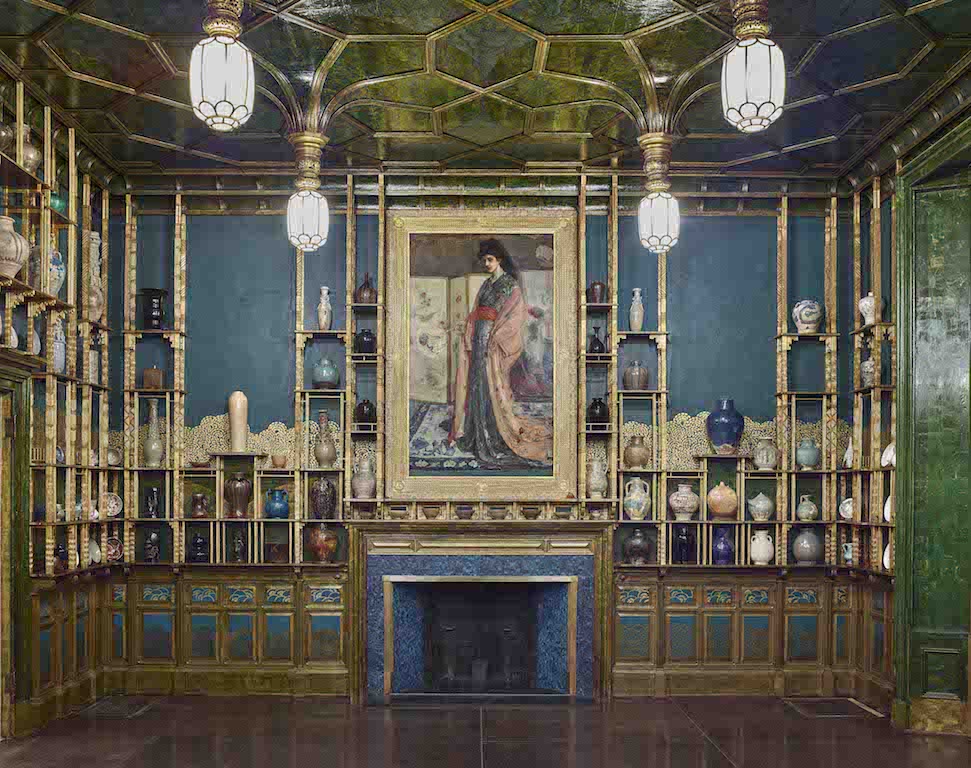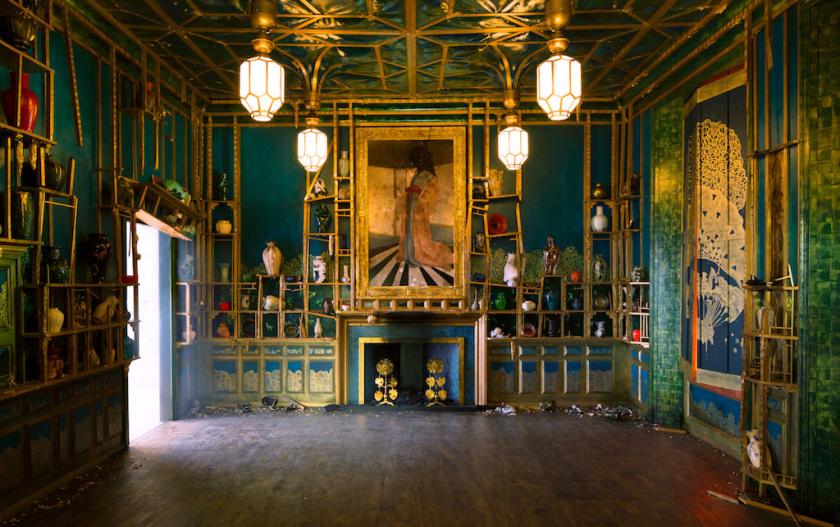It looks as if vandals have ransacked Whistler's Peacock Room. The famous interior was commissioned in the 1870s by shipping magnate, Frederick Richard Leyland to show off his collection of fine porcelain. The specially designed shelves have been broken and their contents smashed; shards of pottery lie strewn across the floor.
The destruction seems also to be coming from within, though; it’s as if some form of vile corruption were infecting the very substance of the exotic room. Over the mantelpiece hangs a painting of a princess by James McNeill Whistler; circles of mould have infected it’s surface and the princess’s dark hair has morphed into a cancerous growth obliterating her face. The delicate patterns painted by Whistler on the ceiling have also turned black and, dripping from the shutters like tears, the gilding is puddling onto the floor. Elsewhere, gold stallectites hang like wasp’s nests from the shattered shelves.
The room was shipped to America in 1904 by the industrialist, Charles Lang Freer who bought it after Leyland’s death. It is now housed in the Freer Gallery, Washington (pictured below), where American artist Darren Waterston encountered it. The story behind the commission inspired him to build Filthy Lucre: Whistler's Peacock Room Reimagined, the facsimile installation on show at the Victoria and Albert Museum (main picture) which imagines the space destroyed by the weight of its poisonous history.
Leyland refused to pay the fee demanded by Whistler for his work on the grounds that it overstepped the brief. Whistler responded by painting two golden peacocks squawking in enmity on the end wall, but in Waterston's version they don’t stop at posturing, but rip out one another’s entrails with their sharp beaks. Subsequently, Whistler was forced to declare himself bankrupt and vented his spleen by painting Leyland in the guise of a demonic peacock obsessed with filthy lucre, named The Gold Scab. A meditation on the uneasy relationship between art and money, Waterston’s installation is very timely. These days, art is too often treated either as an investment opportunity for the stinking rich or, at the other extreme, is destroyed by religious fanatics on the grounds of heresy. Neither response creates a healthy environment for art works or artists. And by offering us an experience of art in ruins, Waterston encourages us to reconsider how we value art and how we use or abuse it.
A meditation on the uneasy relationship between art and money, Waterston’s installation is very timely. These days, art is too often treated either as an investment opportunity for the stinking rich or, at the other extreme, is destroyed by religious fanatics on the grounds of heresy. Neither response creates a healthy environment for art works or artists. And by offering us an experience of art in ruins, Waterston encourages us to reconsider how we value art and how we use or abuse it.
- Darren Waterston Filthy Lucre: Whistler's Peacock Room Reimagined is at the V&A until 3rd May
- More visual arts reviews on theartsdesk









![SEX MONEY RACE RELIGION [2016] by Gilbert and George. Installation shot of Gilbert & George 21ST CENTURY PICTURES Hayward Gallery](/sites/default/files/styles/thumbnail_125_x_125_/public/mastimages/Gilbert%20%26%20George_%2021ST%20CENTURY%20PICTURES.%20SEX%20MONEY%20RACE%20RELIGION%20%5B2016%5D.%20Photo_%20Mark%20Blower.%20Courtesy%20of%20the%20Gilbert%20%26%20George%20and%20the%20Hayward%20Gallery._0.jpg?itok=3oW-Y84i)





Add comment